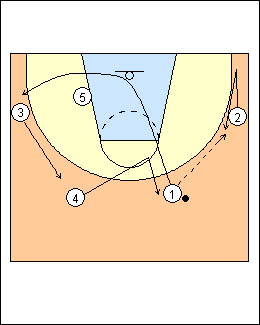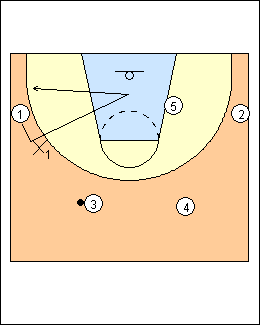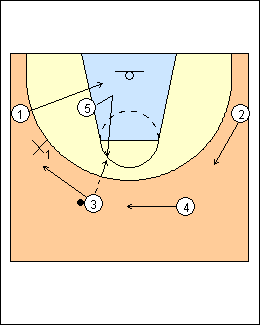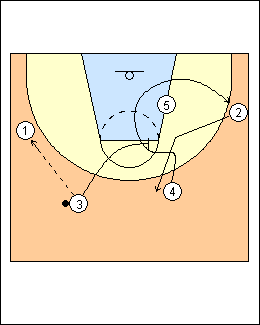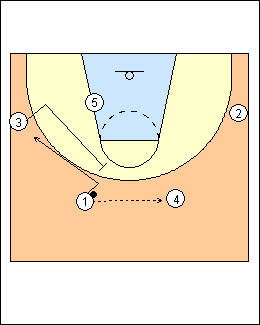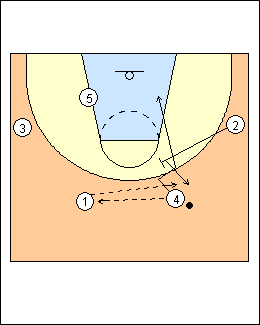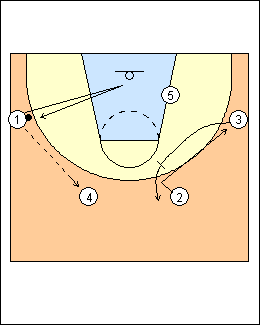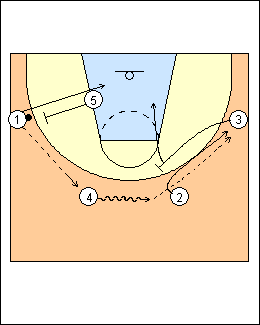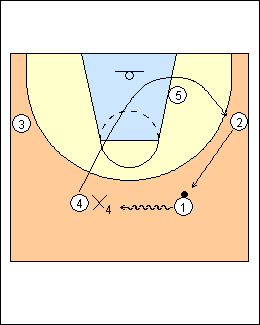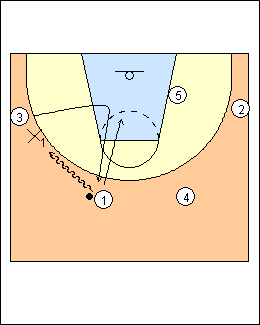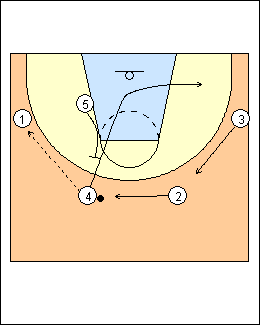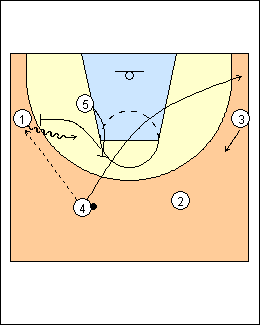4-out 1-in motion
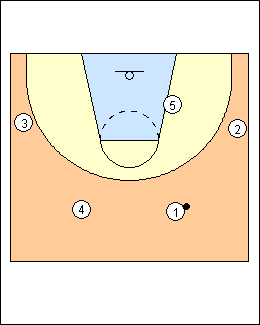 | 1 For less detail, see Offence - 4-out 1-in motion summary.1) low-post movement 2) basket cut 3) backcut 4) screen away 5) passer flarescreen 6) weakside flarescreen 7) dribble-at 8) dribble loop 9) ballscreen with 4 10) handback 11) backscreen with 5 12) flarescreen with 5 13) up-and-down screen with 5 14) ballscreen with 5 15) perimeter backscreen on a skip pass 16) corner cut Swing spots (or guard spots or slots) are one step outside the elbows, wing spots are usually even with the bottom of the circle, but can be foul-line extended (Patrick Hunt), or in the corners to promote dribble-drive action, and low-post 5 would start weakside. Keys - ball and receiver should arrive at the same time - when a spot is vacated, fill it - every passer is a cutter first, stepping towards the pass and reading whether to basket cut or screen - cut to the front of the rim with speed - space out then space up - when you get the ball, get into triple threat and hold for at least a one-count to read the cutter. Kevin Eastman - when in doubt, spread out. Rick Majerus - use the NBA 3-point line for spacing, always fill the high elbows (slots), squaring the top. Allison McNeill - perimeter players are on the NBA 3-point line, wings are above an "upline" that goes from sideline to sideline through the bottom of the jump circle. The best teams cut, screen, and penetrate, and do them at the right time. Motion is based on reading the defence and the floor. coachesclipboard.ca - the upline is one step below the foul line. |
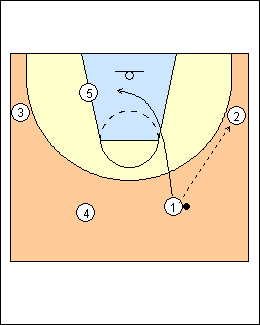 | 2 1) Low-post movement - post directly between the ball and the basket- relocate opposite screening action a) Use an open post to promote dribble-drive action, low-post 5 cleans up or relocates to the other side when a dribbler comes towards him (see Walberg dribble-drive). b) For a more pro-active role, 5 can make block-to-block ball cuts, but usually limited to once or twice per possession. 5 faces in when the ball is at the top or weakside wing, posts up when the ball goes to the ballside wing. Perimeter players follow normal cutting rules, but don't cut in front of a ballside post. Here 1 could cross-screen for weakside 5. See Bauer 4-out 1-in motion for progressions (e.g., duck-ins), and options on a pass to the low-post. Variations for 5 - always relocate opposite the ball - stay on one side - allow one cut from the perimeter before coming to the ball unless already ballside - on ball reversal, change sides to form a triangle unless a teammate is entering the lane. FIBA youth offence - a swing player who passes to either side screens away for all outside players away from the ball. Here 1 would screen away for 4 then 3. Another option is that 1 screens for 5, other perimeter players rotate. If 5 is ballside, 3 can stack behind 5 then break for an entry pass. Tubby Smith - one big stays inside, opposite the ball. Jamie Dixon - 5 can be ballside or weakside, an open post gives room to backcut or curl cut. 5 doesn't flash cut a lot (follow the ball), he backscreens, and seals on the weakside as the ball is reversed. Rick Torbett - 5 stays on one side of the floor to keep the other side open for cutters and layups, and to emphasize his strong hand. The corners are empty so wings can drive baseline without getting defensive help from that side. If a ballside low post is defended on the high side then the wing can drive baseline, and vice versa. Rick Majerus - posts are allowed only one flash cut per possession during their freshman and sophomore year, and are encouraged to wait until the 3rd or 4th side of the floor. They shouldn't keep coming across the lane with half-assed cuts that compromise teammates' room to operate. Jeff Van Gundy - no matter what you run it comes down to getting your best offensive player on his favourite side of the floor with a block open. Dave Leitao - 5 sits under the rim in transition then picks a side for the entire possession, leaving the other side open. They designate who can be really aggressive with the ball on the open wing, go knee to knee, beat your man, 75-80% baseline. Attack the defensive weak links. John Carrier - the post basically works the lane area and can pop to the corner (or short corner). He is usually ballside and will change sides of the floor on a guard-to-guard pass, but have him stay on one side if the defence likes to front, it's a great opportunity to seal when the ball is swung. Bill Self high-low motion - the low big posts directly between the ball and the basket, making their defender decide how to play them, and opening up backdoor angles when the ball is at the top. Allison McNeill - the post is allowed one block-to-block cut per possession, only if open. Face in as the ball comes down the floor. Look to duck in when the ball is at the diagonal swing spot or high post and your defender is flat. Vance Walberg - on a post feed the passer "go" cuts opposite the hand the pass is thrown to.  |
 | 4 Progressions b) Basket cut on a swing-swing pass. 1 passes to 4 and basket cuts, 2 fills behind, 1 replaces 2 on the wing. With a ballside low post, 5 could screen for 1 coming out to the wing. Lawrence Frank - swing it and play, don't swing it and stand, if a player swings the ball he must get out by cutting through or screening away (as the preseason progresses they will be allowed to cut and replace or follow with a ballscreen). Matt Painter - you must educate your players about when you have action and when you don't, make them wait, e.g., don't cross sides without a purpose, it's OK when using a backscreen. John Carrier - use L-cuts and V-cuts to fill spots, don't just run a straight line. Frankston Blues - if you are replacing a player who just cut, combine your movement with a lead for the ball. |
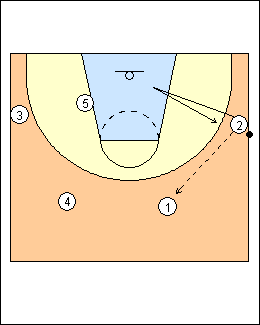 | 5 |
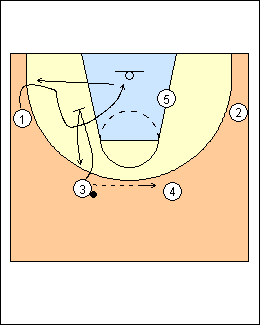 | 8 4) Screen away a) On a swing to swing pass, the passer downscreens for the weakside wing, fist in the air and back to the ball. 3 looks to slip the screen and cut to the basket if open. 1 drags the arc by moving along the 3-point line towards the baseline then comes off the downscreen. 1 curls the screen, or will back-cut (reject the screen) if his defender goes over the screen early. 3 cuts back to the ball to fill the swing spot (hands ready for a pass and shot), 1 spaces back to the wing. Progressions b) allow other reads and cuts, especially if the screener is a non-shooter, i.e., the cutter elbow curls, bumps and fades, or straight (pop) cuts c) 3 can pass to 1 and screen away for 4 d) 3 can pass to 1, basket cut and screen away for weakside 5 e) 3 downscreens for 1, or 1 flarescreens for 3 (see Passer flarescreen). Jeff Bauer - 1 takes two slide steps along the arc, 3 makes a two-step speed cut to the basket then head hunts. Kevin Eastman - the screener's angle is his back to the area of attack. Mike McNeill - the baseline player calls for the downscreen then drags the arc (down to the baseline) to ensure the screen is set below the foul line, and runs at the screener's nose. 1 will curl the screen if his defender runs into the screen or tails him around it. Billy Donovan - 1 walks his man down then shortens the distance to his defender before coming off the screen shoulder to shoulder. Jerry Petitgoue - pass and screen away against sagging defence, screeners come back where they started. Jamie Dixon - curl and screen is an option, 1 curls the screen then screens for 3, a shooter. Jamie Dixon - screening action, everything becomes an exchange. One man to the ball, one man to the basket. Curls and backcuts help to occupy defenders, use only curls/backcuts early in the year, place restrictions in some games just to get movement, certain guys only curl, others only backcut. Guys who can't shoot curl or backcut, attacking the rim. coachesclipboard.ca - 1 curls the screen if X1 tails him, and should run into the screener's defender who is bumping him (cut through contact), helping the second cutter (screener) get open. If the cutter looks at the ball or puts his hands up it will be considered incidental contact rather than an illegal screen. If the screener is a shooter he should 2nd cut to the perimeter, if not he can duck in as the cutter goes by. Another option on a curl is that the cutter goes above the bump for a pass and the screener 2nd cuts directly to the basket for a pocket pass. Jeff Bauer, Mark Few - use designated screeners and cutters. Bob Huggins - screen away with your butt to the ball so the cutter can curl it, then you come straight back to the ball, the passer has to have someone to pass to. If defenders switch, 3 can slip the screen or 1 can make a switch cut - curl around the screen and screen for 3, who curls and 1 comes back to the ball. Have shooters screen for non-shooters, non-shooters backcut, they don't screen. (Option - non-shooters can screen for shooters, the cutter comes to the ball and the screener second cuts to the basket. A switch cut can help get the cutter open even if the defence doesn't switch.) Rick Majerus- don't set a downscreen too low or inside, it distorts screening angles; a lot of switching defences have trouble with a tight curl or backcut (the first look). The screener must space off his screen, returning to the slot on a curl or backcut. Players should have inside foot pivoting, and great shooters have the inside toe already pointed to the rim as soon as they catch (foot organization). Mark Few - 3 screens away or basket cuts. Bill Self - a perimeter player gets behind the arc after screening for another perimeter player, a big slips and finds the ball after screening for a perimeter player. Tony Barone - 1 curls to the elbow if his defender chases, if he curls into the lane his defender can catch up and there is a shot blocker. Don't pop to the wing, there is not enough pressure on the defence. 3 steps out along the baseline looking for a pass from the top. Basketball Australia - it is important for the cutter to read the defence, the general rule is to walk toward the screen, see where the defensive player is, take a step toward the defender, put a hand up as if to catch a pass, then cut where he isn't. Once the cutter has passed the screen, the screener should roll or step through and look to receive a pass (both players should be looking to get open). Another general rule is that "one goes to the basket, one goes to the ball". Matt Painter - using a downscreen on the wing, take your man down, not in, they talk about getting to the baseline (there will be game slippage), it's a sprint. If 1 is below the block in the corner, there's no setting up his man, it's a sprint cut. 3's angle is awful, he must take his man into the middle. They start teaching motion like the defence is switching like-size screens, it's a slip-fade, the screener is always the slipper. 4 dribbles to the action before it happens, he knows they are going to switch. Frankston Blues - the screener's back is generally pointing to the area where you are trying to get the cutter open, the cutter must move into the line of the screen, this means moving in line with the player setting the screen. The cutter decides on his cut once he gets to the line of the screen, and should call his cut. The screener must separate once the cutter uses the screen, normally in the opposite direction. Use the one-in one-out theory, if the cutter attacks the hoop or key the screener will flare or pop to the perimeter, if the cutter moves to the perimeter the screener will seal for a post feed, duck in or flash the key. The curl and back cut put more pressure on the defence as the cut attacks the rim. If the screener defender steps into the cutter's path to bump his curl, the screener can flash to the ballside elbow or pop back where he came from for a shot or closeout opportunity. John Carrier - the cutter can curl, back, flare, or straight cut, the screener should separate hard off the screen opposite the cutter and both should fill. Curl if the defender is trailing, the screener separates hard by popping back to the guard spot (his defender plays low) or flaring to the wing (his defender plays high). Against switching defences, separating hard should take care of it, another thing you can do is slip screens to the basket or have screeners seal and dive to the basket. Ian MacKinnon - if X1 chases around the downscreen, 1 can tight curl (into X3, helping 3 get open), or soft curl if a shooter. See Tactics - Dave Smart using downscreens, Fast breaks - Florida 2005, and Offence - 4-out 1-in situations. |
 | 9 Back cut coachesclipboard.ca - when the defender goes early over top of the screen, the cutter gets to the level of the screen then quickly changes direction, calls "backcut" and goes hard to the basket. Frankston Blues - if the cutter defender tries to fight over the top of the screen or jump switch the screen early then a backcut should be used with the cutter going behind the screen instead of over. It's a great way to relieve pressure against an over-aggressive opponent. The screener should find the ball after the backcut by going back where he came from or flashing to the ball if his defender has to help on the backcut. John Carrier - back cut if the cutter defender is denying, usually waiting on the top side of the screen, the screener can turn and face away from the basket to get a better screening angle then flare to the wing or pop to the guard spot. |
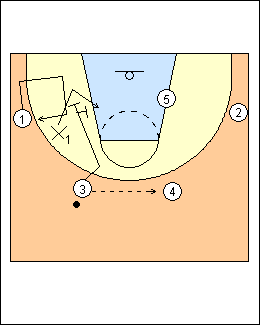 | 10 Bump and fade (flare cut) Jeff Bauer - if xcutter goes ballside of the screen, the screener changes the screen angle to pin the defender in the lane, the cutter stops his cut, pushes off the screener's back, and fades to an open area. The passer shortens the pass with one dribble (take the ball to the screen). Frankston Blues - if the defender is waiting for the cutter on the other side of the screen then the screener should not use the screen and instead flare back away from the screen and defender. The screener will now re-screen to face the ball with their back pointing to the sideline/corner. The passer must skip pass or take a dribble to shorten the pass. On the flight of a pass to the cutter, the screener can step toward the hoop if he is a post player, or pop back where he came from if he is a perimeter player. Bob Huggins - curl if your defender trails, go high if he goes underneath, rescreen and fade if he goes underneath and jumps to the ball. John Carrier - flare if the cutter defender is cheating/sagging in the lane, the cutter flares (backpedals) back to where he started, the screener pops back out to the guard spot, or separates hard to the basket then out to the unfilled perimeter spot. Matt Painter - the screener and cutter both call "change" if the cutter's defender goes around the screen (ballside), the screener turns and head hunts, the cutter should draw a line between himself, the screener's head, and the rim. It's the same thing on a flarescreen. Ian MacKinnon - if 1 does not get a pass from 4 on the bump and fade, when X1 recovers from behind 3's screen 1 goes opposite, middle or baseline. |
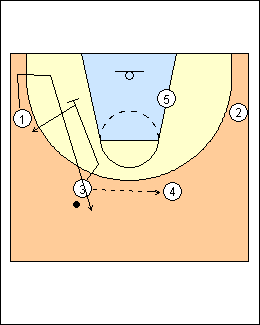 | 11 Straight cut Frankston Blues - if his defender gets caught on the screen then the cutter will straight cut off the screen to catch the ball around the foul line. A straight cut is also used in offence where the downscreen sets up a second action or keeps the weakside busy while keeping away from simultaneous ballside action. The screener will roll, post or space depending on the offence, with 4-out motion you might like him to space out behind the 3-point line to keep the floor spread (shown). John Carrier - straight cut to run clock or with a player who can create with the ball, maybe the point guard. However, very few high school players can properly read a screen with four cuts, so optionally allow only curl and flare cuts, if you give them four cuts they will almost always straight cut to the ball, which is the worst cut to run. |
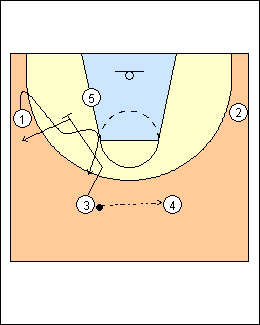 | 12 When there is a downscreen and 5 is on the same side, usually cutter 1 curls then cuts to the elbow area and fills the swing spot, exchanging with 3. However, Tubby Smith wants a curl cut by 1, 5 screens for him coming back out to the wing, and 3 comes back to the ball. coachesclipboard.ca - never cut in front of the post. Mike McNeill - you could have 5 be a second screener on a curl, turn it into a staggered screen, see Up-and-down screen. If 1 rejects 3's screen 5 could backscreen, see Backscreen with 5. For a slip by 3 to have any chance to be effective it would have to be done early, then 5 could duck in or step up the lane for a quick pass, or look over the top to 3 (all this action is not very likely to be effective). Defensively he would force 1 to backcut and go to 5 because there is little space, and doesn't think you would be able to fade against any team that is able to scout or analyze the offence. Bob Huggins - on a flex screen, or when 5 is in the post, other players stay out or clear out (e.g., do not curl a screen). Jeff Bauer - the cutter will semi-curl if there is heavy congestion in the paint, looking for an open area near the foul line or top of the key. The screener second cuts to an open area weakside. Matt Painter - if 5 follows the ball (or is already on the right side), 1 has to pop out if he sees that 4 is trying to get the ball inside to 5 by dribbling down or passing to 2 (also pop out if you come off a downscreen and see that the ballhandler is in trouble). |
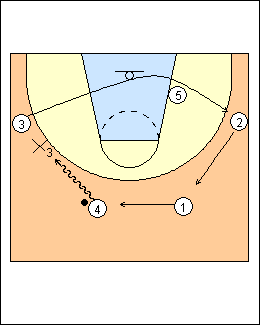 | 19 Here 3 is denied and backcuts when 4 dribbles at X3. Mark Few - backcut on a pass fake or when someone dribbles at you. John Carrier - backcut to the basket and fill the backside. Bill Self - if 3 is denied, it's an automatic backdoor, one bounce by 4, then backcut by 3. If there is no pass on the backdoor, 3 comes back out because X3 has to snap his head if he is overplaying. Gregg Popovich - if denied anywhere on the court, go backdoor and continue in the direction you were going. 3 backcuts and keeps going, 4 dribble hand-offs with 1. Lawrence Frank - if the swing pass to 3 is denied, 4 will pass fake (3 does not backcut) then dribble hand-off with 1. Seth Greenberg - anytime they can't reverse the ball from the high post to the wing, they automatically dribble hand-off back the other way. |
 | 22 If 5 is ballside, 3 loops up using him (zipper cut). See Georgia Tech wrap-to-a-fade entry. Patrick Hunt - if 3 is still denied in the swing spot, 5 sees the overplay and exit cuts to the short corner, creating space for 3 to backcut. Rick Majerus - a loop cut can also be done by dribbling from the wing to the slot, the cutter makes a shallow cut from the slot to the elbow area then to the wing, staying away from the ballhandler. coachesclipboard.ca - 3 can loop under 5 or shallow cut to the slot (see Zipper flare quick hitter).  |
 | 24 |
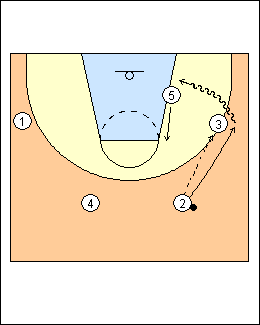 | 25 10) Handback A perimeter player can pass and follow for a handback, or cut off the ballhandler, who can pop, or roll to the basket with an open post, it's like a ballscreen. Option - 1-2-3 can pass and go for a handback, 4 goes to ballscreen (Bob Huggins). Huggins - after passing, a player can basket cut, screen away, or go to the ball for a handback or a rub cut off the ballhandler, do not pass and stand. Use inside handbacks if the on-ball defender sags off, e.g., the defender of a big on the perimeter. On an inside handback, 2 gets the ball and goes baseline, 3 goes middle to the basket. On an outside handback, 2 reads how the defenders are playing him and drives one way or the other (e.g., away from the best defender), 3 goes opposite to the basket, or 2 will shoot from behind if the defenders stand back. coachesclipboard.ca - 2 passes to 3, follows the pass for a hand-back, goes by the screen hip to hip, 3 rolls to the basket after the hand-back, looking for a bounce pass. 3 can fake the hand-back, take one dribble towards the middle and hit cutter 2 going to the basket. Pistol action - 2 passes ahead to 3 and follows for a handback, 4 flarescreens for 3, then ballscreens for 2 if there is no pass to 3. See Fast Breaks - Versoix specials. Pete Newell - a reverse pivot on the inside pivot foot allows you to screen with your back for a hand-off on the perimeter. See Offence - Mike D'Antoni, 2 dribbles off a handback from a big who then ballscreens.  |
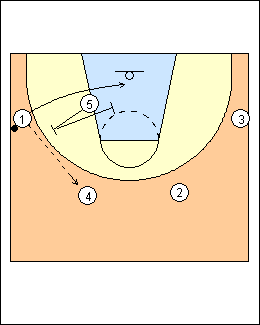 | 26 11) Backscreen with 5 a) If ballside, 5 can backscreen for a wing who passes, then re-screen to get back inside. Variation - 5 backscreens for 1 who then backscreens for 5. Jeff Bauer - the best backscreen is for a player who is overplayed or has just passed the ball. Jamie Dixon - the backscreen is automatic on a wing-to-slot pass on the strongside (post occupied). 5 re-screens for 1 (goes to get him in the lane), then posts up. If X1 goes under the first screen, 1 goes over it (ballside), 5 pops out. If X1 goes over the screen, 5 re-screens, 1 fades to the corner. If X1 goes over the screen then under it, 1 fades high. If the defenders switch, 5 breaks off the screen and cuts to the basket, 1 pops. Dave Smart - turn a big-to-little backscreen into a flare screen, the screener posts up, or slips on a switch, don't go where you are useless (see Using backscreens). Patrick Hunt - if 4 is denied, 5 exit cuts to the short corner. Hoop Tactics, Paul Hewitt - 5 can step out to set a backscreen for any perimeter player and exchange positions. Sylvia Hatchell - when 4 passes the ball, 5 backscreens for 4 and switches positions. Alison McNeill - the post is an active screener. Vance Walberg - automatic backscreen on uphill wing to guard pass, 5 re-screens if X1 goes over top, or pops if X5 helps. Rick Torbett - 5 looks to set backscreens (he can stagger backscreen with a cutter exiting), then be a second cutter and face up. Pin and skip to counter help defence in the lane, the post sets a pin screen on the defender closest to the ball with the most distance to recover, then seals in the post on a skip pass. Pin and skip may be the best single weapon against zone. Jeff Bauer - the post looks to pinscreen on the lane line any weakside defender who is in or near the paint. Dave Leitao - sometimes they will always have 5 backscreen for the passer when the ball is on the strongside wing, 5 doesn't get it, and a pass is made out top. 5 can re-screen for 1, or pop out as pressure release then re-screen if he doesn't get the ball. Matt Painter - there's no switch on a big-to-little backscreen, 1 goes to get his layup, 5 pops, pass to him if he can shoot or the ballhandler is getting a count or is pressured. If 4 has his 4-4-4 seconds (not dribbled yet), he's fine. On a downscreen, if X1 trails the cutter (the defence won't switch a big-little screen), 1 curls, hit him, and 5 dives. If X1 goes around the screen (ballside), 5 changes his angle to lay some wood, 1 fades to the corner. John Carrier - optionally the wing downscreens for the post. |
 | 27 Progressions b) Ballside 5 can backscreen if the wing is overplayed with the ball at the swing spot (or flash to the high post for a blind pig). Barker - the best denial option is a simple screen by 5 for 1. Villanova Pin - 1 face cuts to the rim and clears back out using a pin screen from 5. Mark Few - 5 can backscreen then re-screen for 1 and get back in the post. |
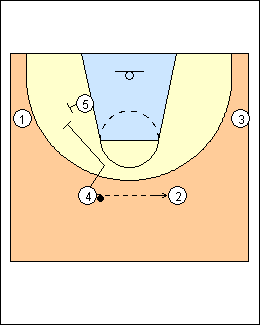 | 28 c) Ballside 5 backscreens for the wing on a swing to swing pass. 1 can use 4's diagonal screen or the backscreen from 5 (Jamie Dixon, Barker triangle offence), who then re-screens. breakthroughbasketball.com - 5 backscreens for 1 on a pass to the other side of the floor (from 1 to 2, 1 to 3, 4 to 3, or even 4 to 2). Bob Huggins - 1 flex cuts on the pass to 2, 4 downscreens for 5 if 5 is a shooter (flex), otherwise 5 ducks in behind the cutter. coachesclipboard.ca - Steve Alford "wheeling" - if 1 goes off 5's backscreen then 5 cuts off 4's downscreen; if 1 comes off the downscreen, 5 flarescreens for 4. Mike McNeill - if 1 rejects 4's screen 5 could backscreen then immediately duck in as the cutter goes by. 1 should either cut into X5 (incidental screen) or simply cut and try to influence X5 to go with the cut for a step or two. Option - if 4 basket cuts after passing to 2, 5 could screen for 4 coming out to the weakside wing. |
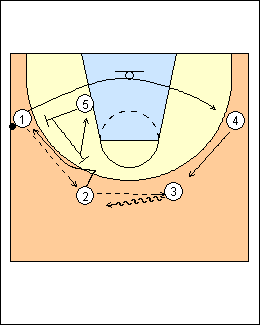 | 30 12) Flarescreen with 5a) Backscreen-flarescreen 5 backscreens for 1, flarescreens for 2, then dives to post up. 1 backcuts and keeps going (to empty the wing), 3 dribbles over to shorten a pass to 2 and create space for 4 and 1 to fill behind (or fills the swing spot after passing to 2). Option - if 3 dribbles over, 5 UCLA screens on a pass to 2. Bauer - an effective movement is to rear screen then immediately flarescreen, the two hardest screens to defend set by the best screener. After setting the flare screen 5 can dive into the post or out cut for a shot or ball reversal. Post flarescreens are a great way to feed the post, if X5 stays in the paint, 5 should sprint into the paint and seal for a post feed from 2. If X5 helps on the flare, 5 may seal him out. Jamie Dixon - 5 backscreens for 1, flarescreens for 2 then posts up. 3 brings it on the dribble, 4 and 1 fill behind. 2 takes his man in (get him ballside) then backs out, hands ready, butt down. If X2 goes over the screen, 2 is probably looking to sweep baseline. If X2 goes under the screen, 2 pops out, 5 re-screens (turns to downscreen). |
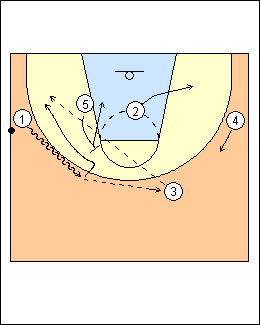 | 31 b) Dribble-up flarescreen 2 has passed to 1 and cut to the basket, 1 dribbles up from the wing to the empty slot and passes to 3, at the same time 5 steps out of the post, follows the dribbler and sets a quick flarescreen as 1 passes. 3 would fill the swing spot on the dribble or after passing to 1. Option - 5 steps out as a ball reversal option, then dives inside on a catch and pass to 1. Dave Leitao - if 1 dribbles out to fill the top (e.g., 3 is late replacing 2), then 5 will flarescreen for 1. 3 gets his passing angle in order, it's a two-man game with 5 on a pass back to 1. See Quick hitters - Dribble up to flarescreen, and C (double flare).  |
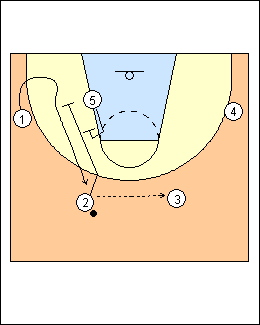 | 32 13) Up-and-down screen with 5coachesclipboard.ca - up and down action can create a staggered screen, when 5 sees a downscreen (on his side of the floor), he can go up the lane to set a second screen for the cutter. Mike McNeill - have the cutter curl through the elbow area off the second screen, 5 looks for a pocket pass if the cutter gets a pass, or 5 looks for a pass over the top if X5 steps up and bumps the curl. First screener 2 always second cuts to the perimeter and looks into 5 posting if he gets a pass. Either way 5 gets back into the post. Jeff Bauer - up and down screen - the post jogs up the lane line to the elbow, turns his back to the ball then downscreens. A post player should be the last screener in a combination screen to prevent switching. If 2 and 3 stagger screen for 1, an up and down screen by 5 can create a triple screen. An up and down screen could also be a single screen, the post must communicate his intention to screen early. See the North Carolina fast break - 2 and 5 would stagger screen for 1, 2 goes first, 5 walks up the lane, defenders are less likely to switch with 5 as the top guy in the screen. Any time they have a two-man game on one side they have a stagger on the other side, a big guy is the second screener. See the Gonzaga offence - the bigs stagger screen for a shooter, 5 is the bottom screener, 4 (the passer) is the top screener.  |
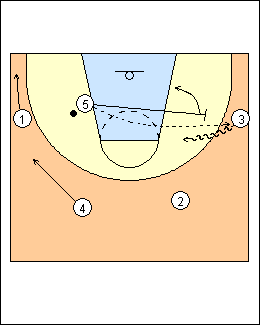 | 34 b) 5 can pass and follow to ballscreen. Here 5 has the ball at the low post, fans opposite to 3, follows to ballscreen, and can set a flat (butt) screen so that 3 can go either way (see Bill Self ballscreen offence and Florida 2006 fast break). Options - 4 dives weakside on the ballscreen - don't ballscreen on a pass out to 4. Bill Self - from 3-out 2-in, a low post can chase any pass out to ballscreen, the other low post gets to the weakside block. Here 2 would cut through as if he had reversed the ball. 5 would also ballscreen for 3 if 2 got the pass from 5 and quickly reversed it. |
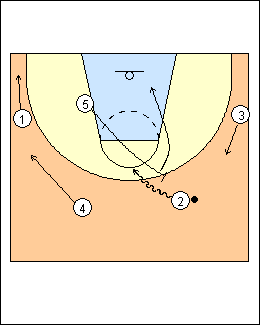 | 35 c) Spread fist 5 can come up to ballscreen for a swing ballhandler. 4 and 1 space away, 3 fills behind the screen. The ballscreen can be flat or angled. See Van Gundy shake ballscreen. PG shallow cut quick hitter - 5 sprints up to set a random ballscreen on 2's catch. A random ballscreen is not scripted or drawn up, it occurs instantly on a catch. Tony Bergeron - ballscreen with 5 to get a big defender out of the post, 4 can go over the top behind 2 or backcut. Villanova spread offence (FIBA Assist 37) - 5 starts in the post and sprints to either slot to set a ballscreen, with his back parallel to the sideline. 4 and 1 will exchange to create movement and occupy the weakside defenders. Mark Few - as his defender helps on 5's roll, 3 fills up back behind the screen. A 4 that can shoot in the fill spot is extremely dangerous. Bill Self - 5 ballscreens then downscreens for 3. Dave Leitao - Phoenix screen - they will allow 5 to come out of the post, particularly if the ball is at the top, sometimes for pressure release but most often for a ballscreen. A lot of times at the end of the shot clock it's a flat screen, the wings drop to the corners, the ballhandler's partner spaces out. See Fast breaks - Versoix specials.  |
 | 36 15) Perimeter backscreen on a skip pass On a skip pass from 1 to 2 (wing to swing), 1 can basket cut then backscreen for 2 on a pass to 3 or 4. 5 backscreens for 1 if on the same side. See the Larry Brown secondary break.  |
 | 37 16) Corner cutOn a swing-to-wing pass, the passer can basket cut, or corner cut if the wing player is high enough. Then always fill four perimeter spots, but not necessarily the swing and wing positions. Progression - the passer can corner cut on a swing to swing pass, the wing player moves up to make space as needed. See Georgia Tech 4-out 1-in motion, and Walberg dribble-drive motion. Jeff Bauer - have a player cut to the ballside corner against trapping defences. Mark Few - when we throw the ball to the corner we want it out of there, dribble out. Dave Smart - if you get the ball in the corner, make a play, you can't hold it. Cutters 5-out motion (see Youth offence)- pass to the corner to avoid a 5-second call, then basket cut, the corner player can immediately dribble out to the wing and be replaced by the cutter. |
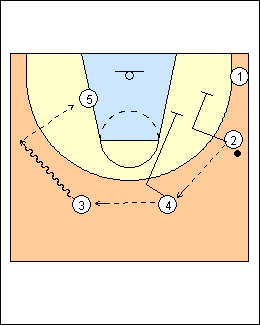 | 38 Naked post (Rick Majerus) The corner cut by 1 isolates 5 on his side of the floor with no attacker on the wing. The ball is reversed to 3 who dribbles to the wing for an improved passing angle, 2 and 4 stagger for 1 to draw away help. Don't feed the post from the slot unless it's a lob, it's better to go too low for a post feed than be too high. Another option is an open-side flare, 2 passes to 4, 5 steps up to the elbow to set a flarescreen for 3 then dives to the block on a catch by 3. A corner cut can set up a shuffle cut and/or stagger screen, e.g. see Argentina flex.  |
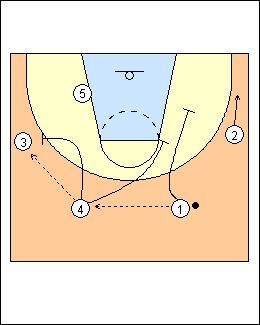 | 39 Combining steps and progressions from above, an example of motion rules would be: - with the ball, attack the basket, pass fake, pass, or dribble-at for a hand-off, backcut, or to turn the corner - after passing, basket cut, corner cut, screen away, ballscreen, or go get a handback - one pass away from the ball, backcut if overplayed or on a pass fake - other players without the ball fill cut as needed on a basket cut or backcut - there are no ball flashes from the weakside - 5 starts weakside, cleans ups and relocates - if ballside, 5 can backscreen for a wing who is overplayed, ballscreen if the wing gets the ball, or backscreen if the wing passes. These general rules can be refined, e.g., 1-2-3 can pass and go for a handback, 4 can pass and go to ballscreen. Against pressure, use pass fakes, backcuts, dribble-ats, backscreens, blind pigs, and dribble entries (loop), also get the ball inside, and drive the basket. Some motion offences emphasize cutting (e.g., Petigoue Iowa), others emphasize screens away from the ball (Petitgoue Pick), and this can be a useful teaching progression (also see Paul Hewitt 3 on 3).  |
This page was made with Basketball playbook from Jes-Soft
